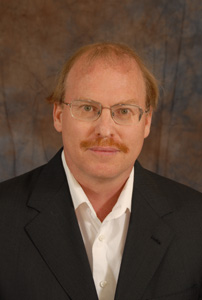Rodney S. Ruoff
Rodney S. "Rod" Ruoff (* 1957 ) is an American chemist ( nanotechnology ).
Ruoff graduated from the University of Texas at Austin with a bachelor's degree in chemistry in 1981 and received a PhD in chemical physics from the University of Illinois at Urbana-Champaign in 1988 . In 1989 he was a Fulbright Fellow at the Max Planck Institute for Flow Research in Göttingen and in 1990/91 as a post-doctoral student at the IBM Watson Research Center. From 1991 to 1996 he was a scientist at the Molecular Physics Laboratory at SRI International . In 1997 he became an associate professor at Washington University and from 2000 to 2007 he was the John Evans Professor for Nanoengineering at Northwestern University , where he headed the Biological Inspired Materials Institute from 2002 to 2007 . From 2007 to 2013 he was a professor at the University of Texas at Austin (Cockrell Family Regents Chair). He is Professor at the Ulsan National Institute of Science and Technology (UNIST) in Ulsan , South Korea and Director of the Center for Multidimensional Carbon Materials (CMCM).
Ruoff researches new types of carbon materials in nanotechnology such as fullerenes , carbon nanotubes , graphene and graphene oxide , diamond structures. For example, he investigated the solubility of fullerenes, their mechanical behavior under high pressure, large fullerenes that enclose metals, chemically modified graphene for electrode materials and anti-corrosion layers, and various methods of creating graphene layers and patterns. By 2017 he had published around 470 scientific papers and held 43 patents.
He is a Fellow of the American Physical Society , the Materials Research Society, and the American Association for the Advancement of Science .
Ruoff is one of the highly cited scientists ( Clarivate Citation Laureates 2018). Eight of his works were cited over 5000 times, two over 10,000 times. He received the Lee Hsun Award and the Turnbull Award from the Materials Research Society. In 2017 he received the James C. McGroddy Prize from the American Physical Society for his pioneering contributions to the scalable synthesis, materials science and applications of graphene and graphene derivatives (laudation).
Fonts (selection)
- with S. Stankovich u. a .: Graphene-based composite materials, Nature, Volume 442, 2006, pp. 282-286
- with S. Stankovich u. a .: Synthesis of graphene-based nanosheets via chemical reduction of exfoliated graphite oxide, Carbon, Volume 45, 2007, pp. 1558-1565
- with X. Li u. a .: Large-area synthesis of high-quality and uniform graphene films on copper foils, Science, Volume 324, 2009, pp. 1312-1314
- with DR Dreyer, S. Park, CB Bielawski: The chemistry of graphene oxide, Chemical Society Reviews, Volume 39, 2010, pp. 228-240
- with MD Stoller u. a .: Graphene-based ultracapacitors, Nano Letters, Volume 8, 2008, pp. 3498-3502
- with Y. Zhu u. a .: Graphene and graphene oxide: synthesis, properties, and applications, Advanced Materials, Volume 22, 2010, pp. 3906-3924
- with S. Park: Chemical methods for the production of graphenes, Nature Nanotechnology, Volume 4, 2009, p. 217
- with MF Yu u. a .: Strength and breaking mechanism of multiwalled carbon nanotubes under tensile load, Science, Volume 287, 2000, pp. 637-640
- with DA Dikin, S. Stankovich u. a .: Preparation and characterization of graphene oxide paper, Nature, Volume 448, 2007, p. 457
- with Y. Zhu u. a .: Carbon-based supercapacitors produced by activation of graphene, Science, Volume 332, 2011, pp. 1537-1541
Web links
Individual evidence
- ^ McGroddy Prize , Eureka Alert. Reason: for his pioneering contributions to the scalable synthesis, materials science and applications of graphene and graphene derivatives (laudation).
| personal data | |
|---|---|
| SURNAME | Ruoff, Rodney S. |
| ALTERNATIVE NAMES | Ruoff, Rod (nickname) |
| BRIEF DESCRIPTION | American chemist (nanotechnology) |
| DATE OF BIRTH | 1957 |
